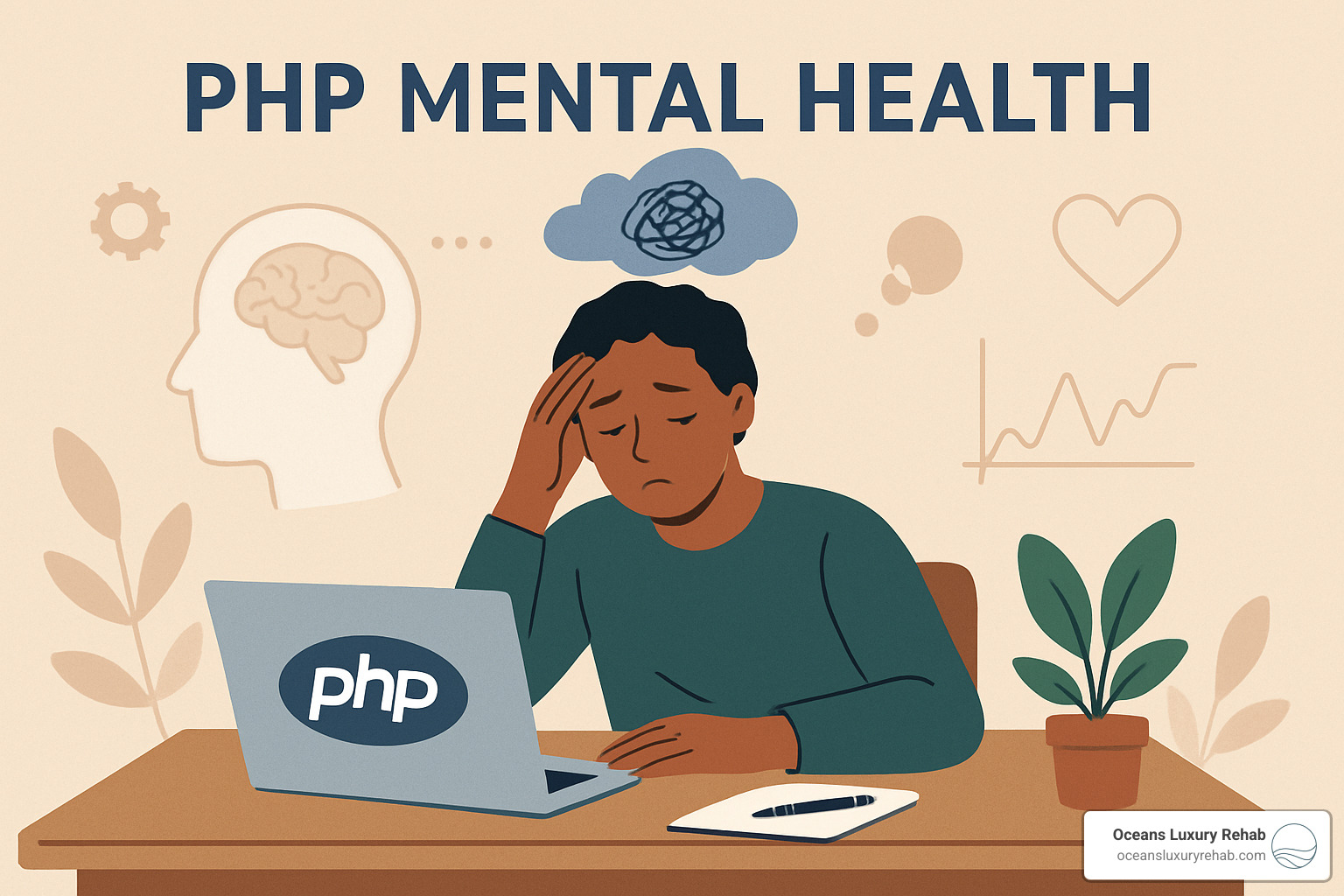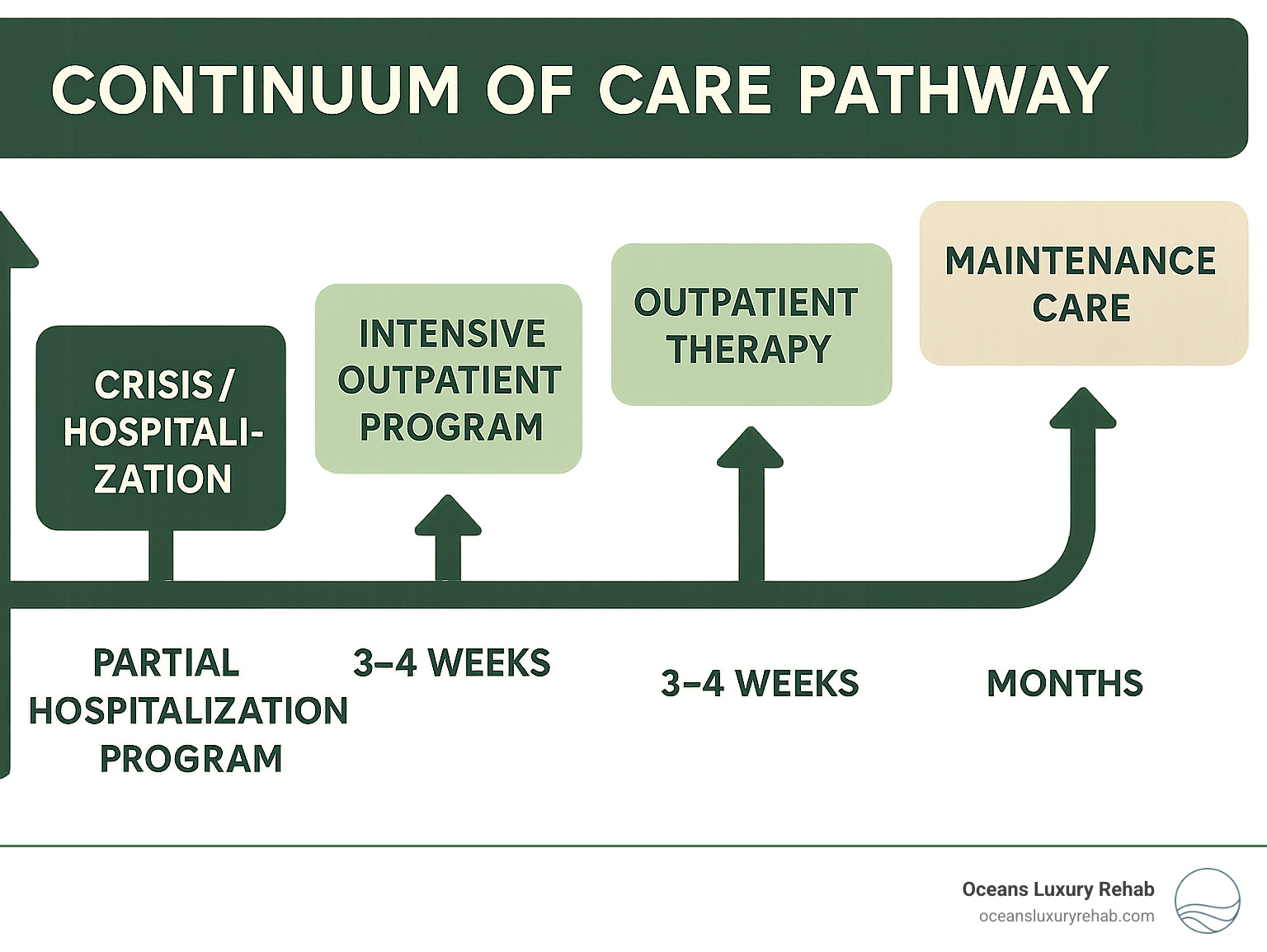Understanding PHP Mental Health: Your Bridge to Recovery
PHP mental health programs offer a structured middle ground between inpatient hospitalization and traditional outpatient therapy. Here’s what you need to know:
Quick Answer:
- What it is: Partial Hospitalization Program providing 20+ hours of weekly therapy while living at home
- Who it’s for: People needing intensive support but not 24/7 supervision
- Duration: Typically 2-8 weeks, 5-7 days per week
- Coverage: Often covered by Medicare and private insurance when medically necessary
- Cost: $50-$300 daily out-of-pocket with insurance
More than one in five U.S. adults live with a mental illness, yet many fall into a treatment gap. They need more support than weekly therapy sessions but don’t require round-the-clock inpatient care.
PHP bridges this gap perfectly. You attend intensive therapy during the day—typically 7-8 hours of group sessions, individual counseling, and medication management. Then you return home each evening to practice new skills in real-world settings.
This model works especially well for professionals who want to maintain some work flexibility while getting serious help. You’re getting hospital-level care without the hospital stay.
The research backs this up. Studies show PHPs can provide efficient and cost-effective care for many patients who would otherwise need inpatient treatment. They often prevent hospitalization entirely or significantly shorten stays while delivering excellent recovery outcomes.
I’m Clint Kreider, and I’ve spent over 13 years helping people steer PHP mental health programs and other treatment options in both clinical and private practice settings. My experience has shown me that PHP often provides the perfect balance of intensive support and real-world application that many people need for lasting recovery.

Learn more about php mental health:
PHP Mental Health: Inside Partial Hospitalization Programs

Think of PHP mental health programs as the sweet spot in treatment options. They emerged in the 1960s when Dr. Albert E. Moll recognized that many people needed intensive care but couldn’t leave their families or jobs behind. It was a idea at the time—what if we could provide hospital-level treatment while letting people sleep in their own beds?
Today’s PHP mental health programs require at least 20 hours of therapeutic services per week to meet Medicare requirements. This isn’t just a random number—research shows this intensity creates the momentum needed for real change while keeping you connected to your daily life.
The magic happens in how comprehensive these programs are. During your day, you’ll experience individual therapy sessions where you dive deep into personal challenges, group psychotherapy where you connect with others facing similar struggles, and medication management with board-certified psychiatrists who can adjust your treatment in real-time.
But it doesn’t stop there. Psychoeducational groups teach you the science behind your symptoms, life skills training helps you steer daily challenges, and holistic interventions like art therapy and mindfulness give you creative ways to heal. It’s like having a whole toolkit of healing approaches available every single day.
The range of conditions we treat in PHP mental health programs is extensive. Mood disorders like depression and bipolar disorder respond particularly well to the intensive structure. Anxiety disorders—whether generalized anxiety, panic disorder, or OCD—benefit from daily skill practice and support.
Trauma-related conditions including PTSD and complex trauma find healing through specialized approaches we can only offer with this level of intensity. Eating disorders get comprehensive support including therapeutic meals and body image work. For personality disorders like borderline personality disorder, we offer specialized DBT programming that’s incredibly effective.
Dual diagnosis cases—where mental health and substance use challenges occur together—are actually some of our strongest success stories. Instead of treating these separately, we address both simultaneously. And even psychotic disorders like schizophrenia can be treated effectively in PHP when symptoms are stabilized.
Scientific research on PHP effectiveness backs up what we see every day—significant improvements in depression and anxiety symptoms that often last months after completion.
php mental health vs inpatient, residential & IOP
Understanding where PHP mental health fits helps clarify when it’s your best option. Inpatient care provides 24/7 medical supervision in a hospital setting—essential for crisis situations but intensive and expensive at $1,000-2,000 per day. Residential treatment offers round-the-clock clinical support in a facility setting, typically costing $500-1,500 daily, perfect when you need constant structure.
PHP mental health programs bridge this gap beautifully. You receive 20-30 hours of weekly treatment with daily clinical supervision, but you go home each evening. At $250-600 per day, it’s significantly more affordable than residential options while providing much more intensity than traditional outpatient care.
Intensive Outpatient Programs (IOP) offer 9-12 hours weekly, meeting 2-3 times per week, ideal for maintaining progress while returning to work or school. Standard outpatient therapy provides 1-3 hours weekly for ongoing support and prevention.
The beauty of PHP mental health programs lies in their flexibility. You get hospital-level care without giving up your own bed, your pets, or your evening routine. Many clients in Orange County love that they can attend our program during the day and still enjoy the beaches and community life in the evenings.
Who Is a Good Candidate for php mental health?
PHP mental health programs work best when several factors align. Your symptom severity needs to be significant enough to interfere with daily life—think depression that makes work feel impossible, anxiety that’s limiting your relationships, or trauma symptoms disrupting your sleep. But you also need to be stable enough to safely return home each evening.
Safety and stability are crucial. This means no active suicidal plans, no severe substance withdrawal requiring medical monitoring, and no psychotic symptoms that impair your ability to distinguish reality. You don’t need to be symptom-free, but you need to be safe.
Your home environment matters too. Whether it’s supportive family, good friends, or simply stable housing, you need some foundation to return to each day. Some clients live alone but have strong social connections. Others have family members who understand and support their treatment journey.
Motivation for change is essential because PHP mental health programs require active participation. You’ll be showing up consistently, engaging in groups, completing assignments, and practicing new skills at home. It’s intensive work that pays off when you’re ready to engage.
Medical stability means any physical health conditions are managed and don’t require 24-hour monitoring. Your body needs to be stable enough to handle the emotional work of intensive therapy.
Co-occurring disorders often respond beautifully to PHP mental health programs. When you’re dealing with both mental health and substance use challenges, our integrated approach addresses everything simultaneously rather than treating them separately. More info about Dual Diagnosis shows how we customize care for these complex situations.
We see particularly strong outcomes with professionals stepping down from inpatient care who need to gradually return to work responsibilities, college students managing anxiety or depression while maintaining academic goals, adults with trauma histories who need intensive processing but want the comfort of their own beds, and individuals with eating disorders who benefit from structured support while maintaining family connections.
Therapies & Daily Schedule in php mental health

A typical day in our PHP mental health program runs 7-8 hours and flows naturally from morning check-ins to afternoon wrap-up. You might start at 9:00 AM with a community meeting where everyone sets daily goals and connects with the group. Process group therapy from 9:30-11:00 AM explores emotions and interpersonal dynamics—often the most powerful part of many people’s day.
Individual therapy sessions happen mid-morning, giving you focused one-on-one time to work on personal challenges. After a lunch break (which might include therapeutic meals for eating disorder clients), you’ll dive into skills-based groups focusing on CBT, DBT, or trauma-specific techniques.
Experiential therapy in the afternoon—art, music, or movement—helps you process emotions in new ways. The day wraps up with goal review and homework assignments that bridge your program experience with your evening at home.
The therapeutic approaches we use are all backed by solid research. Cognitive Behavioral Therapy (CBT) helps you identify and change negative thought patterns that fuel depression and anxiety. Scientific research on evidence-based psychotherapy consistently shows CBT’s effectiveness across multiple conditions.
Dialectical Behavior Therapy (DBT) teaches emotional regulation, distress tolerance, and interpersonal skills. Originally developed for borderline personality disorder, these skills benefit almost everyone in PHP mental health programs. Learning to “ride the wave” of intense emotions instead of being knocked over by them is life-changing.
Group psychotherapy provides something individual therapy simply can’t—the power of peer connection. Clients often tell us that realizing they weren’t alone in their struggles was changeal. Groups become laboratories for practicing new social skills and receiving real-time feedback.
Medication management with our board-certified psychiatrists happens 2-3 times weekly, allowing for careful adjustments and side effect monitoring that’s impossible with monthly outpatient visits. This intensive monitoring often leads to better medication outcomes in shorter timeframes.
Trauma-informed care integrates EMDR, somatic experiencing, and trauma-focused CBT for clients with PTSD or complex trauma. The intensive nature of PHP mental health programs allows for deeper trauma processing than weekly sessions typically permit.
Holistic approaches including art therapy, mindfulness meditation, yoga, and outdoor activities help develop alternative coping strategies. Our Orange County location lets us incorporate beach walks and nature-based interventions that complement traditional therapy beautifully.
Family therapy often plays a crucial role, especially for adolescents or when family dynamics contribute to mental health challenges. Healing happens in relationships, so involving loved ones when appropriate strengthens recovery.
Measuring Progress & Length of Stay
Progress in PHP mental health programs shows up in multiple ways. We track standardized symptom scales like the PHQ-9 for depression and GAD-7 for anxiety weekly, giving us concrete data about your improvement. But numbers only tell part of the story.
Functional improvements matter just as much—are you sleeping better, returning to work, engaging in relationships again? Skill application becomes crucial—can you actually use those DBT distress tolerance techniques when your boss criticizes you or your partner seems distant?
Safety factors are always monitored closely. Has self-harm decreased? Are suicidal thoughts less frequent or intense? Treatment engagement shows us how actively you’re participating in groups and completing homework assignments.
Weekly treatment team reviews involve your primary therapist, psychiatrist, and other relevant staff. We adjust your treatment plan based on progress, setbacks, and emerging needs. It’s like having a whole team of professionals collaborating on your recovery.
Length of stay varies significantly based on your unique situation. Research shows typical PHP mental health programs last 2-8 weeks, but we’ve seen successful outcomes in as little as 10 days for some clients and several months for complex cases.
Severity of symptoms at admission influences duration, as does complexity of diagnoses—dual diagnosis cases often need longer to address both mental health and substance use challenges. Home environment stability, previous treatment history, co-occurring medical conditions, and insurance coverage all play roles in determining length of stay.
Step-down criteria focus on safety and stability rather than perfect symptom elimination. You’re ready to transition when you can maintain safety without constant supervision, use coping skills independently, function in your home environment, engage in less intensive treatment, and manage psychiatric medications with minimal monitoring.
The goal isn’t to fix everything in PHP mental health programs—it’s to stabilize you enough to continue healing in a less intensive setting while maintaining the gains you’ve made.
Costs, Insurance & Transitioning After PHP

Understanding the financial aspects of PHP mental health programs helps families plan appropriately. The good news is that most insurance plans, including Medicare, cover PHP when it’s deemed medically necessary.
Medicare Coverage: Medicare Part B covers partial hospitalization mental health services when you meet specific criteria. You need a doctor or qualified mental health professional to certify that you would otherwise require inpatient care. The minimum requirement is 20 hours of therapeutic services per week.
Private Insurance: Most private insurance plans cover PHP mental health services, but coverage varies significantly. Typical out-of-pocket costs range from $50-$300 per day with insurance, depending on your deductible, copay structure, and whether the provider is in-network.
Cost Breakdown Without Insurance:
- Short-term programs (under 30 days): $6,000-$12,000 total
- Long-term programs: $9,000-$18,000 per month
- Daily rates typically range $250-$600
Several factors influence costs:
- Geographic location (Orange County tends to be higher than national averages)
- Facility amenities (luxury settings vs. basic clinical spaces)
- Staff credentials (board-certified psychiatrists vs. residents)
- Specialized programming (trauma-specific, eating disorders, dual diagnosis)
- Additional services (family therapy, psychiatric testing, medication management)
Admission Process & Coverage Checklist for PHP Mental Health
Getting into a PHP mental health program involves several steps, but we help streamline the process:
1. Initial Assessment (Usually Free)
- Clinical interview to assess symptoms and functioning
- Review of previous treatment history
- Safety assessment
- Determination of appropriate level of care
2. Insurance Verification
- We contact your insurance to verify benefits
- Determine if pre-authorization is required
- Clarify your deductible, copay, and out-of-pocket maximum
- Confirm the provider is in-network
3. Physician Certification
- A doctor must certify that you need PHP mental health services
- Documentation that you would otherwise require inpatient care
- Treatment plan outlining goals and expected duration
4. Pre-Authorization (If Required)
- Submit clinical documentation to insurance
- Provide treatment rationale and expected outcomes
- Appeal if initially denied (we help with this process)
Coverage Checklist:
- ✓ Verify PHP is covered under your mental health benefits
- ✓ Confirm the provider is in-network
- ✓ Understand your deductible and copay requirements
- ✓ Check if pre-authorization is needed
- ✓ Ask about session limits or duration caps
- ✓ Clarify coverage for medication management
- ✓ Understand appeal processes if claims are denied
More info about Partial Hospitalization Program details our specific admission process and what to expect during your first week.
Stepping Down, Aftercare & Long-Term Success

The transition out of PHP mental health programs is just as important as the intensive treatment phase. We don’t just discharge you and hope for the best—we create a comprehensive aftercare plan.
Typical Step-Down Progression:
- Intensive Outpatient Program (IOP): Usually 9-12 hours per week, 3-4 days
- Standard Outpatient Therapy: Weekly individual and/or group sessions
- Maintenance Care: Monthly or as-needed sessions for ongoing support
Essential Aftercare Components:
Continued Therapy: Most clients transition to weekly individual therapy with a provider who understands their PHP mental health experience. We help coordinate this handoff to ensure continuity.
Medication Management: Ongoing psychiatric care, usually monthly initially, then quarterly as stability improves.
Peer Support: Many clients benefit from support groups, whether formal (like NAMI support groups) or informal peer connections made during PHP.
Crisis Planning: We develop detailed crisis intervention plans, including:
- Warning signs of symptom recurrence
- Specific coping strategies to try first
- When and how to reach out for help
- Emergency contacts and resources
Lifestyle Modifications: Sleep hygiene, exercise routines, stress management, and social connection strategies learned in PHP need ongoing reinforcement.

Long-Term Success Factors:
Research on PHP mental health outcomes shows several factors predict sustained recovery:
- Skills Practice: Clients who continue using CBT and DBT techniques learned in PHP maintain gains longer
- Social Support: Strong family and peer relationships buffer against relapse
- Treatment Engagement: Following through with aftercare recommendations significantly improves outcomes
- Lifestyle Stability: Maintaining regular sleep, exercise, and stress management routines
- Early Intervention: Recognizing warning signs and seeking help quickly prevents full relapse
Crisis Resources for Ongoing Support:
- 988 Suicide & Crisis Lifeline: Call or text 988 for immediate crisis support
- SAMHSA Treatment Locator: findtreatment.gov helps locate local mental health services
- Crisis Text Line: Text HOME to 741741 for crisis counseling
- Local Emergency Services: 911 for immediate safety concerns
When to Consider Returning to Higher Levels of Care:
Sometimes people need to step back up to more intensive treatment. This isn’t failure—it’s smart healthcare. Consider returning to PHP mental health or higher levels if you experience:
- Persistent suicidal thoughts or self-harm urges
- Inability to function at work, school, or home despite outpatient support
- Substance use relapse affecting mental health stability
- Medication changes requiring closer monitoring
- Major life stressors overwhelming your coping skills
- Family or relationship crises impacting recovery
At Oceans Luxury Rehab in Orange County, we maintain relationships with our PHP mental health graduates. Our doors are always open for booster sessions, family consultations, or stepping back up to higher care when life gets overwhelming.
The journey through PHP mental health treatment is rarely linear. Some days will be harder than others, and that’s completely normal. What matters is having a solid foundation of skills, supportive relationships, and professional resources to help you steer whatever comes next.
Recovery is possible, and PHP mental health programs provide an excellent launching pad for the ongoing journey. With the right support, most people go on to live fulfilling, meaningful lives while managing their mental health proactively.
Whether you’re considering PHP mental health treatment for yourself or a loved one, seeking help is a sign of strength, not weakness. In our experience across Orange County and beyond, the clients who do best are those who approach treatment as an investment in their future rather than a punishment for their struggles.
We’re here to help you determine if PHP mental health treatment is right for your situation and to support you every step of the way toward lasting recovery and wellness.
